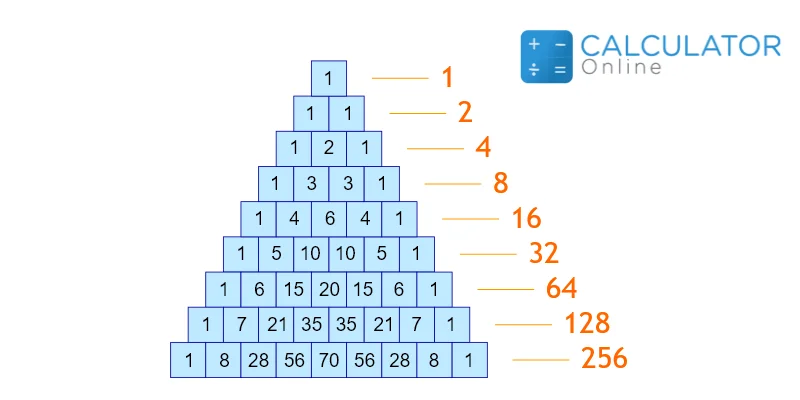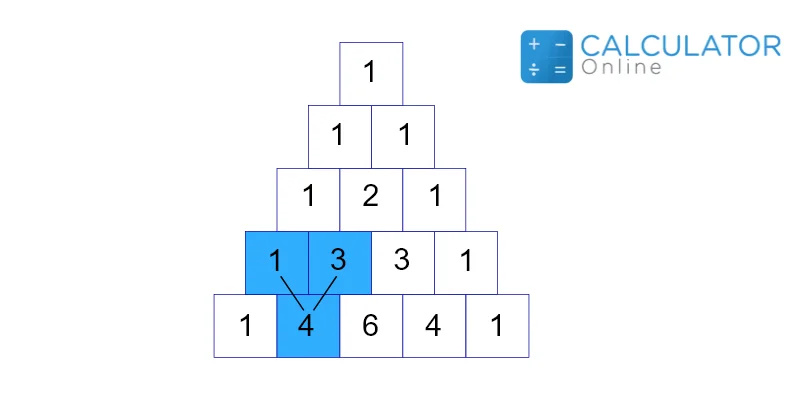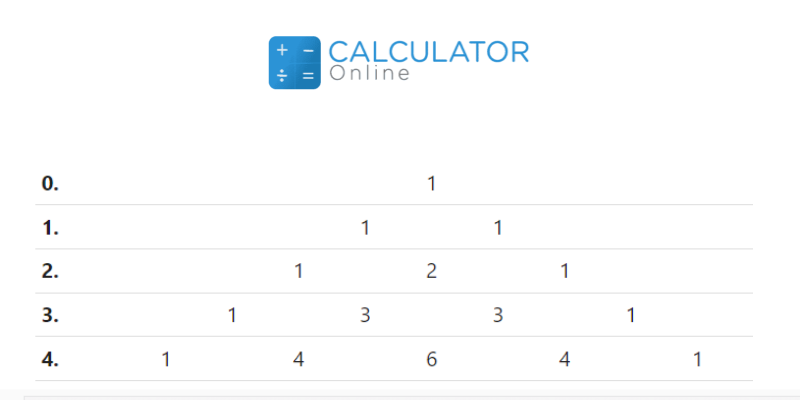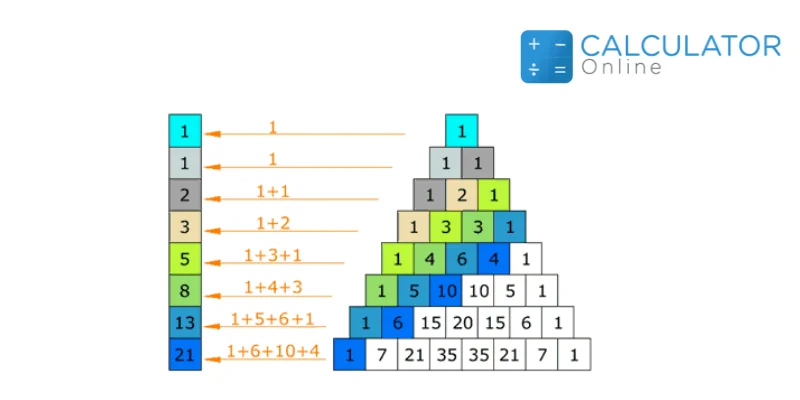Adblocker Detected

We always struggled to serve you with the best online calculations, thus, there's a humble request to either disable the AD blocker or go with premium plans to use the AD-Free version for calculators.
Disable your Adblocker and refresh your web page 😊
Table of Content
The Pascal’s triangle calculator generates multiple entries of a specific binomial expansion. It provides important information about the coefficient in a specific row of the binomial series.
Pascal’s triangle calculator makes it easy to understand the binomial theorem and its expansion.
Let’s have a look at what is pascal’s triangle, and how to use pascal’s triangle to make the binomial expansion melaborative.
Pascal’s triangle is named after Blaise Pascles, a famous French Mathematician and Philosopher. The Pascal Triangle arrangement makes clear the number of rows(n) and the column(k) such that each number (a) in a given row and column is calculated.

It makes our task much easier and simpler to find the coefficient at a specific place of the binomial series.
Don’t be too confused with the binomial expansion, as Pascal triangle formula generates critical information. The column notation actually begins with 0, the first value is stored in the first value of the array 0, the second row of the pascal triangle is 1, the third is 2, and so on. The first row is a_1,0, the second is a_1,1, the third number is a_1,2, and so on.
$$ a_{n,k} \equiv \frac{n!}{( k! (n – k)! )} \equiv \binom{n}{k} $$
Where:
n!= The number n value
k!= The number k value
Now k!<= n!
Let’s make the task much easier for ourselves, the binomial coefficient calculator is utilized to find the binomial expansion. It provides us with sufficient information regarding the binomial series. The pascal calculations make the task much easier for us, to spot at which point the coefficient is placed.
There are multiple benefits of Pascal’s triangle
In the binomial expansion of (a + b)^4, the coefficients of each term are the same for the nth term of Pascal’s triangle. Pascal’s triangle expansion calculator makes u possible for us t predict future combinations.
Consider an expression (a+b)^4 the coefficient of each term of XY terms are as 1, 4, 6, 4, 1
Pascal’s triangle formula for (a+b)^4 is given below:
Pascal triangle formula can be generated by the next number in the triangular pattern.
For example, we have highlighted (1+3 = 4), the same we generated (1+2 = 3). For quick retrieval of the expansion, pascal’s triangle binomial expansion calculator is responsive and fast. Expand using Pascal’s triangle calculator expand, and make the result more resonating for yourself.

Choose the number of rows from the Pascal triangle formula to expand the coefficient with the coefficient. (a + b)^4 has a power equal to “4” starting for 1,4 is:

(a + b)^4 = 1 4 6 4 1
We have coefficient 1 4 6 4 1, attach them with the terms of (a + b)^4 in the same order as the coefficients are appearing in the proceeding order:
(a + b)^4 = 1a + 4ab + 6ab + 4ab + 1b
Place the power to the variables a and b. Power of a from 4 to 0, and power of b should go from 0 to 4.
(a + b)^4 = 1a^4+ 4a^3b + 6a^2b^2 + 4ab^3+ 1b^2
(a + b)^4 = a^4+ 4a^3b + 6a^2b^2 + 4ab^3+ b^2
We have done the Binomial expansion by the (a + b)^4 using Pascal triangle formula. Pascal’s triangle calculator expand provides us with the values of the binomial expansion in simple steps.
The Fibonacci Sequence is one of the most difficult sequences to understand. Now with the help of Pascal calculations, it can be easy to understand the sequence.

The Fibonacci Sequence starts by “0,1 and then continues by adding the two previous numbers 3+5=8,Pascals triangle row 8, and the next series Fibonacci Sequence number would be 5+8=13, which is the pascal’s triangle 13th row. The Pascals triangle calculator makes the Fibonacci Sequence easy to understand.
Pascal’s triangle formula is implemented to find the values in various rows.
Considering Pascal’s triangle formula, we have presented the expected values in the table below: the power of the series is actually the row number. The Pascals triangle calculator makes the coefficient of each row easy for us to understand.
|
Pascal’s Triangle Row |
Coefficient value |
|
8th row |
1,8,28,56,70,56,28,8,1 |
| 9th row |
1,9,36,84,126,126,84,36,9,1 |
|
10th row |
1,10,45,120,210,256,210,120,45,10,1 |
| 11th row |
1,11,55,165,330,462,462,330,165,55,11,1 |
|
13th row |
1,13,78,286,715,1287,1716,1716,1287,715,286,78,13,1 |
| 15th row |
1,15,105,455,1365,3003,5005,6435,6435,5005,3003,1365,455,105,15,1 |
|
20th row |
1, 20, 190, 1140, 4845, 15504,38760, 77520, 125970, 167960, 184756, 167960, 125970, 77520,38760, 15504, 4845, 1140, 190, 20, 1 |
| 30th row |
1, 30, 435, 4060, 27405,142506, 593775 2035800, 5852925, 14307150, 30045015 54627300, 86493225, 119759850, 145422675 155117520, 145422675, 119759850, 86493225, 54627300, 30045015, 14307150 5852925, 2035800, 593775, 142506, 27405 4060, 435, 30, 1 |
The Pascal triangle calculator enable us to predict the coefficient of the even 20th row or 30th row binomial expansion.
Let’s go through the working guide of this free Pascal triangle calculator that lets you calculate the instant results as
Input:
Output:
The result produced by the Pascals triangle calculator is as follows:
The horizontal sum of all the numbers is doubled each time when we are adding them, so we got the pattern as 1,2,4,8…, and we got the multiple of a power of 2 in all the powers of the 2. Pascal’s triangle binomial expansion calculator confirm all the expansion of Pascal’s triangle.
The triangle is symmetrical, the numbers on the left-hand side have identical matching numbers on the right-hand side like the mirror image. We can expand using Pascal’s triangle calculator and can find the same mirror image values.
The exponent of 11 actually represents the number of rows of Pascal’s triangle.
We can predict the coefficient of a specific row and column by the pascal’s triangle formula. The Pascal’s triangle calculator makes the task easy for the users, and we can understand the Binomial expansion more explicitly.
From the source of Wikipedia: Pascal’s triangle, Formula
From the source of Britannica.com: Quiz, Pascal’s triangle